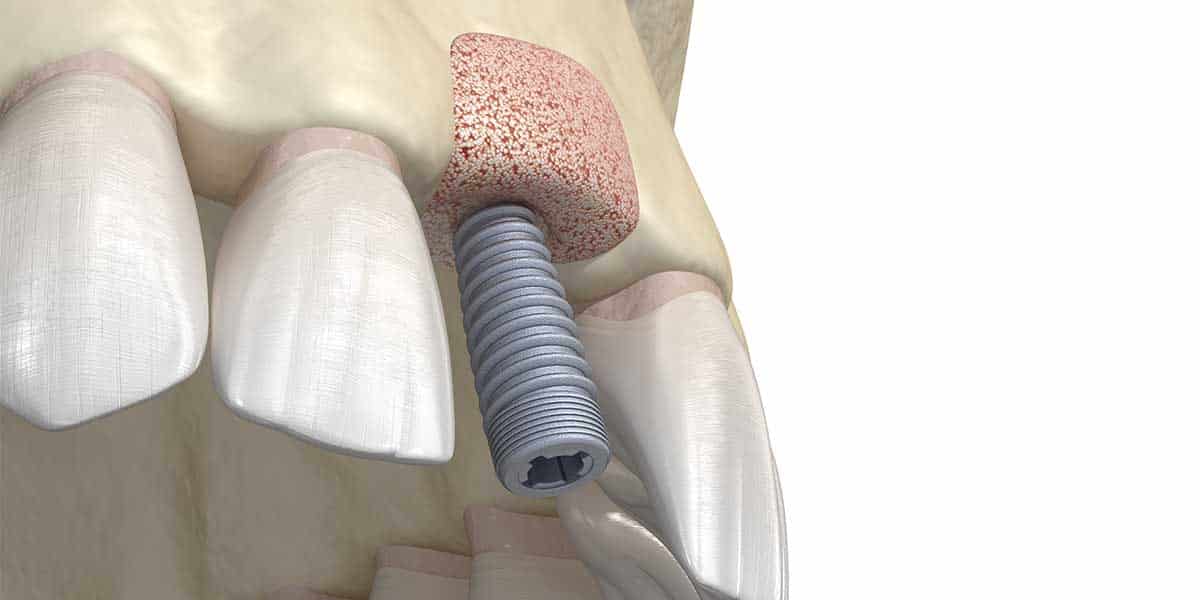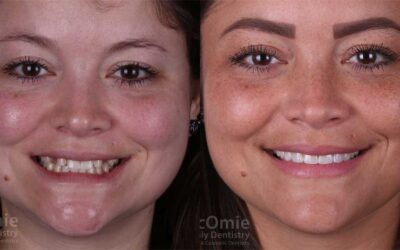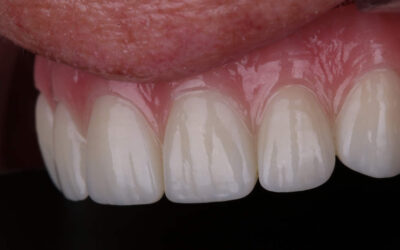If you’re about to undergo dental implant surgery, our Chattanooga dentist might recommend a dental bone graft. Dental bone grafting helps to reinforce that portion of your jaw bone, ensuring a stable foundation to support the future dental implant procedure. The reason being is because it’s natural for bone to resorb (shrink or dissolve) at the location of a missing tooth. Bone loss doesn’t just affect the potential for future dental implants, it also alters the shape and youthfulness of your facial profile. Dental bone grafts are a great long-term solution for anyone with a missing tooth.
As an experienced implant provider, Dr. McOmie may incorporate dental bone grafts into dental implant procedures and full mouth reconstruction cases. The overall goal is to establish healthy bone tissue prior to your planned surgical procedure.
What is a Dental Bone Graft?
Bone grafting is a method of strengthening weak areas of your jaw bone due to bone loss. It essentially involves the installation of synthetic or donor bone grafting material into the open socket, where the tooth root once stood. A few months after transplanting healthy bone tissue into this area, the bone graft material integrates and becomes a permanent part of your jaw.
A socket graft can be performed at the same time as an extraction, ensuring a predictable healing process and reducing the need for future procedures. We can also go back and place a block bone graft at a later point in time.
Sometimes the additional bone mass is needed years after tooth loss. Like in the instance of a sinus lift, where our Chattanooga dentist or an oral surgeon will be installing dental implants in your upper arch of teeth.
Why Healthy Bone is Essential
Human bone can gradually “dissolve” when affected by disease or infections, like periodontitis. The alveolar bone along the top of our jaw will also shrink from the pressure of wearing dentures, or the loss of multiple (or all of our) teeth. But bone material is what helps support things like teeth and dental implants. To promote stability during smile reconstruction or a dental implant procedure, the patient must first have healthy bone to support their smile.
Even if you don’t plan on preserving teeth or placing implants, you still need enough alveolar bone to ensure lower or upper jaw stability for wearing a denture. Your own body will not recreate bone in that space. However, if we install a dental bone graft at that location, the overall dental health and stability of that location will improve. At that point, we can predictably plan on installing a replacement tooth/dental implant procedure.
Are Bone Grafts Painful?
The bone graft healing process is relatively painless. However, the initial placement of bone graft material is a minor procedure where local anesthetic will be necessary. Fortunately, bone tissue doesn’t have the same type of pain receptors as our skin or gum tissues. The relatively minor procedure may result in some minor irritation where the surgical incision was made, but an over-the-counter pain reliever should be all that’s necessary after your dental bone grafting appointment.
There are, however, some types of bone graft methods that, when paired with other oral surgeries, can require a longer recovery period. Our Chattanooga dentist will discuss these circumstances with you well ahead of time so that you can know exactly what to plan for prior to scheduling a dental bone graft appointment.
Is it Possible to Avoid Getting a Bone Graft?
Someone who has suffered bone loss has already likely undergone surgery, development defects, gum disease, injuries to their mouth, or even wisdom teeth removal. The idea of a second surgical incision to place a dental bone graft may sound overwhelming. But is it necessary for their dental health? In many cases, yes, the new bone will be an integral part of the dental services available to restore your smile. Fortunately, once we achieve healthy supporting tissues, it’s possible to maintain the stable foundation you’ve created. Additionally, you get to enjoy offsetting any sagging facial features which so frequently accompany tooth loss.
Without healthy or new bone, adult teeth and dental implants will lack the surrounding tissues they need to support normal biting and chewing force. The little natural bones left behind will be inadequate for balanced oral healthy or day-to-day activities. Even if the gum tissue is healthy and active gum disease is eliminated, you will have complications develop if there isn’t enough new bone material around the teeth you want to preserve. The ultimate goal is to ensure you have enough bone so that you’re not eating soft foods for the rest of your life.
How to Know if You Need a Bone Graft
Requiring a dental bone graft is always something that our dentist will recommend on a case-by-case basis. Depending on your oral health history and planned procedures, we will make appropriate suggestions. A full-mouth scan or X-ray will be required beforehand so that we can evaluate your current bone anatomy, locate any alternative spaces for implant placement, and consider long-term health complications that may require a bone graft. Without these diagnostic images, it is not possible to know one way or another if you will need a bone graft/socket graft.
Are There Different Types of Bone Graft Procedures?
Yes. The reason behind getting a dental bone graft is because of various scenarios, be it tooth replacement, implant installation, or even reducing tooth loss after treating gum disease.
A socket graft is one example. This immediate bone transplant is set into the open socket at the time a tooth is removed (extracted.) As your body heals, the dental bone integrates with the surrounding jaw, reducing the loss of osseous tissue in that space.
Another example is when we’re adjusting the height of your jaw so that you can comfortably wear a full denture. Otherwise, the uneven bone levels could result in a loose, uncomfortable prosthesis that you don’t feel comfortable wearing. We call this a “bony ridge modification”.
One procedure that always calls for a dental bone graft is a sinus lift. Whenever someone loses their upper molars, the nasal sinus lining that used to rest above those tooth roots will start to sink into the open socket space. In those scenarios, it is physically impossible to install a dental implant without first lifting the lining of the sinus cavity. To do so, a dental bone graft must be set in that space, preventing the lining from dropping or the implant from perforating the sinus cavity.
Bone Graft Consultations
Have you been told that you need a bone graft? Reserve a consultation at McOmie Family Dentistry today for a professional consultation.




